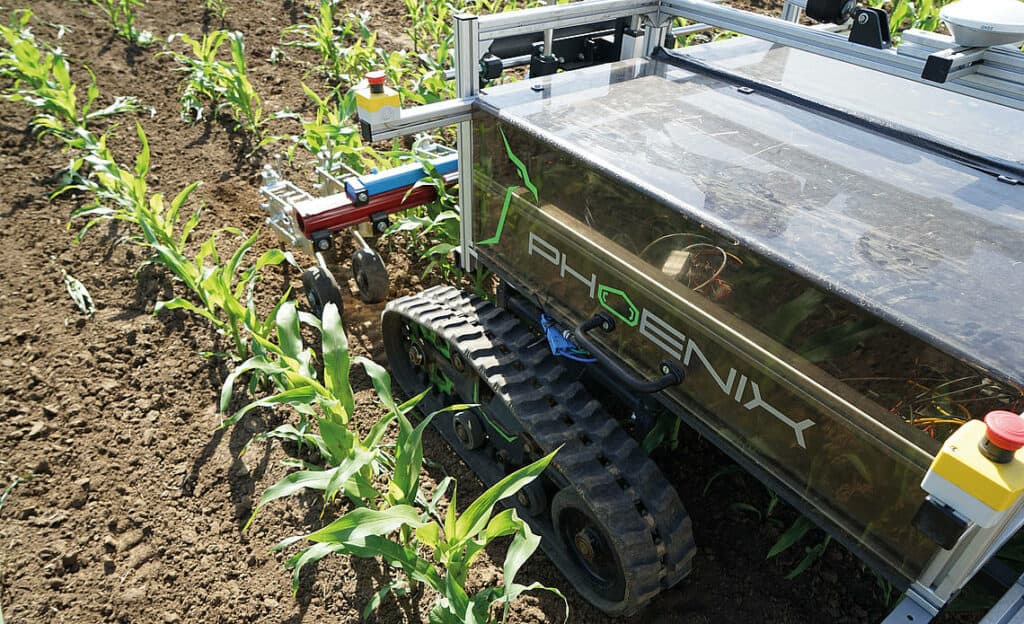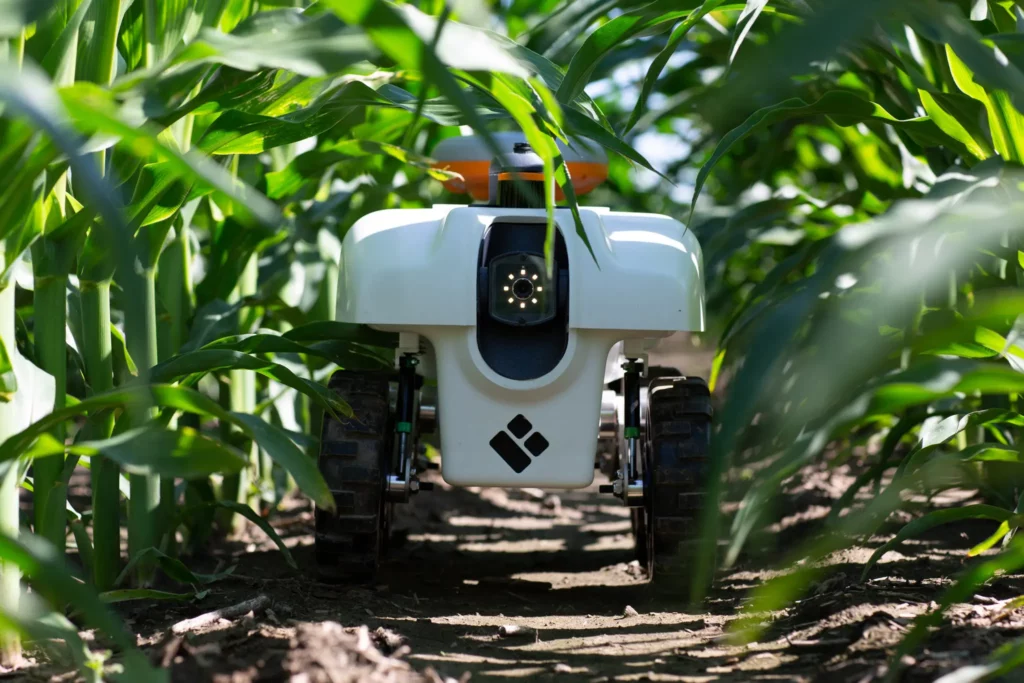What Is A Robot Farm?
Since food production is one of the significant sources of carbon emissions, it’s exciting to know that farming technology continues to develop that make farmers more productive with less energy.
This technology is enabling non-professionals to carry sophisticated, complex farming work in their own backyards. Much of this technology involves robotics, but perhaps a more mundane way to describe it is simply automation. These concepts give rise to that of the robot farm.

Definition: A robot farm, also referred to as an automated or smart farm, is an agricultural setting where various tasks, from planting to harvesting, are carried out by automated machines or robots.
These tasks might include activities like sowing seeds, monitoring crop health, applying fertilizers or pesticides, and harvesting crops.
The objective of a robot farm is to increase efficiency, reduce human labor, enhance precision in farming practices, and potentially lessen the environmental impact of agriculture.
Automation is very common on a modern farm.
Through automation, a single farmer is able to manage many acres of productive farm land.
There are many types of automation which give rise to the concept of a robot farm. Let’s take a look at a few examples.
Corteva Farm Drone
A drone flies over a field of corn and measures the height of the stalks.
What used to be manually measured and required dozens of people to complete now takes a few hours. Corteva is one company that manufactures and sells these drones.

Earthsense Autonomous Vehicle
The Earthsense is a small robot, akin to Wall-E, trundles along a field.
Fully autonomous, this robot is measures early vigor, corn ear height, soybean pods, plant biomass, and detects and identifies diseases and abiotic stresses.
Earthsense makes this line of Terrasentia robots.

The impact of this technology on the farming industry is that it allows for more efficient and accurate farming.
This technology can help farmers to map their crops, plan their planting, and predict their yields.
This end result is the optimization of their production and to better decision-making about their farming practices.
Farm.Bot
The FarmBot is an open source, combo software and hardware system, that lets one manage an area of 2.9 meters × 1.4 meters with a maximum plant height of 0.5 meters.
The system lets the user cultivate multiple crops in the same area. It works indoors and outdoors. Sophisticated software enables management of complex mixture of produce.
/
Robot farms first became popular in the early 21st century as a way to reduce the cost of labor.
Companies could save money on wages and benefits by replacing human workers with robots.
Additionally, robots don’t unionize or go on strike, and they could work around the clock if necessary.
Finally and most importantly, robots have the ability to make high precision measurements quickly and repetitively.
What Types Of Robots Are Made In Robot Farms?
The robots that are being developed for farming are able to carry out different tasks:
- Detect and pick strawberries.
- Identify weeds and calculate the amount of herbicide
- Analyzing soil and plants
- Collect thousands of data points for breeding and optimization of crops
How Are Robots Made?
The process of making a robot usually begins with the design phase.
During this phase, engineers create plans for the robot’s body and programming.
Once the design is complete, the robot is ready to be assembled.
Assembling a robot generally requires two types of workers: those who put together the robot’s physical body and those who write its software code.
Body assembly workers typically have a background in engineering or robotics, while software coding workers often come from a computer science background.
After the robot is assembled, it undergoes a series of tests to ensure that it is functioning properly.
Once the robot passes these tests, it is ready to be shipped to its customer.
What Is A Farmbot?
A Farmbot is a type of robot that is specifically designed for agricultural applications.
Farm bots are typically used to perform tasks such as planting, watering, and harvesting crops.
They can also be used to herd livestock and perform other agricultural tasks.
Farm bots come in a variety of sizes and shapes, but they all share some common features.
Most farm bots have sensors that allow them to navigate their surroundings and avoid obstacles.
Additionally, many farm bots are equipped with GPS systems, which allow them to be controlled remotely.
Farm bots are becoming increasingly popular as a way to reduce the cost of labor in agriculture.
They can work around the clock and do not require breaks or vacations. Additionally, farm bots are less likely to cause damage to crops than human workers.
What Are The Advantages Of Farms Run by robots?
There are several advantages to using robot farms.
First, robot farms can help companies reduce labor costs. Because robots can work around the clock and do not require breaks or vacations, they can be operated at a lower cost than human workers. Additionally, robot farms can help companies increase production by allowing them to operate 24 hours a day, 7 days a week.
Second, robot farms can improve product quality. Robots are capable of performing tasks with a high degree of precision and consistency. This can lead to higher-quality products and fewer defects.
Third, robot farms can help companies reduce their environmental impact. Because robots are more efficient than human workers, they can help companies save energy and resources. Additionally, robot farms generate less waste than traditional manufacturing facilities.
What Are The Disadvantages Of Robot Farms?
There are also some disadvantages to using robot farms.
First, robot farms require a high upfront investment. Companies must purchase the robots and build the infrastructure to support them. Additionally, training workers to operate robot farms can be costly and time-consuming.
Second, robot farms can be inflexible. Once a robot farm is built, it is difficult to make changes to the facility or the robots themselves. This can limit a company’s ability to respond to changes in the market or customer demands.
Third, robot farms can be dangerous. If a robot malfunctioned, it could cause injury to workers or damage to property. Additionally, robot farms are typically equipped with sensors and other safety features that can fail.
Fourth, robots are not fully autonomous yet. The TerraSentia trips over debris on the ground, or its wheels get stuck, which requires a human to unstick it and set it back on its path.
The Future Of Robot Farms
The future of robot farms is uncertain. However, robot farms will likely become more common as companies look for ways to reduce labor costs and increase production.
Additionally, robot farms could become more widespread as they become more efficient and capable. As robot farms become more prevalent, it is important to consider the ethical concerns associated with their use.
In the United States, robot farms are becoming increasingly popular as a way to reduce labor costs. The use of robot farms is also growing in other countries, such as Japan and South Korea.
Final Thoughts
Robot farms have several advantages, including increased production, improved product quality, and reduced environmental impact.
However, robot farms also have some disadvantages, such as high upfront costs and inflexibility.
Additionally, there are some ethical concerns associated with robot farms, such as job loss.
Despite these concerns, robot farms are likely to become more common in the future as companies look for ways to reduce labor costs and increase production.
